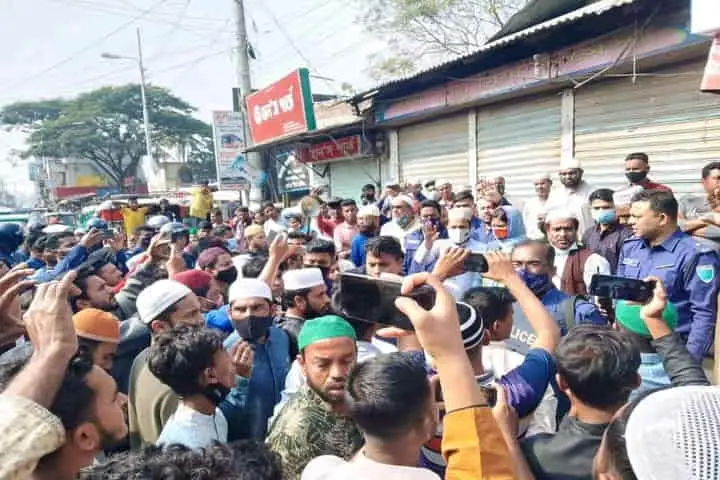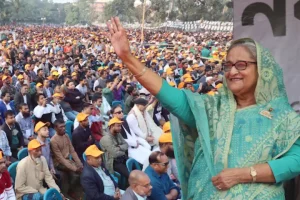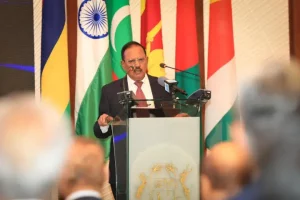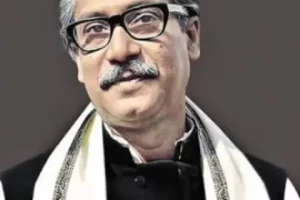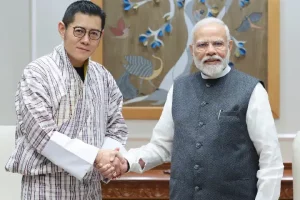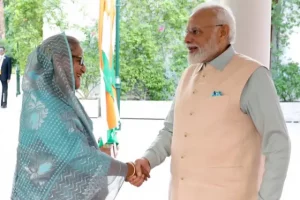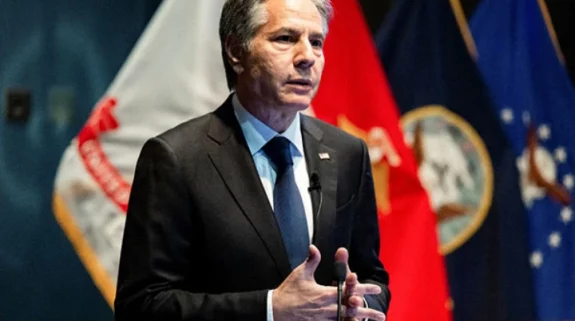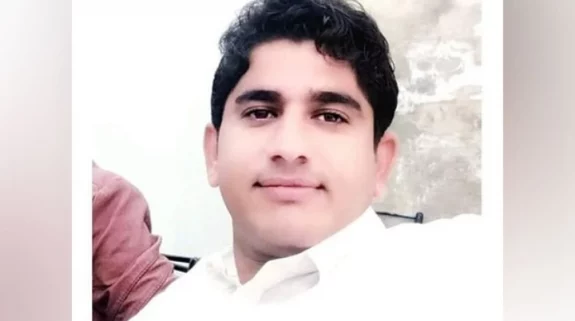The spurt of incidents of attacks on Hindu minority community in Bangladesh in recent times brings into focus the increasing influence of Islamists in that country despite the Hasina government’s profession of secularism and its attempt to maintain that credential. Islamism in Bangladesh is rising precipitously, permeating every aspect of life and has taken root as much in urban centres as in rural communities. To quote a perceptive analyst: “Everywhere – from modern business office to daily social life – Islamic codes tend to exert authority. Burqa and hijab-wearing women who vow to uphold such a system are numerous, and so are men with Islamic zeal. Two decades ago, most Bangladeshis would have considered such behaviours ludicrous”
Sufferings of the community continues since the mayhem that took place during the Durga puja in October last when Hindu properties were looted, their houses were burnt into ashes leaving four people dead and many others injured, temples were desecrated and set on fire over a contrived blasphemy issue of the copy of Holy Koran found near the image of Hindu God Hanuman. The government had to deploy para-military forces in 22 districts of Bangladesh then.
Video:
Our sister Tulsi Gabbard has just condemned the attack on Hindus temple in Bangladesh.
But I am surprised that the Prime Minister of Hindutva in India, Narendra Modi, did not open his mouth about the attack on Hindu temples in Bangladesh.
Thanks Tulsi Gabbard❤️🇧🇩 pic.twitter.com/57NCvO86RC
— Raju Das 🇧🇩 (@RajuDas7777) October 20, 2021
The latest incident took place on February 8 when five brothers of a Hindu family were crushed to death injuring two others of the same family by a pick-up truck in what is believed to be a ‘premeditated’ attack according to the surviving members of the family. The incident took place in Chakaria Upazila in Cox Bazar district in the Chittagong Division of Bangladesh. ’Hindu Lives Matter’, an organization that has sprang up recently has reported about another incident of physical violence and forceful occupation of a clinic-cum –residence of a Hindu family outside Dhaka by a well-known film actor named Jayed Khan and his associates. Examples of such torture and harassment of Hindu families abound.
Even while the Sheikh Hasina government is mindful of the predicaments of the Hindu minority and tries to protect them from the onslaught of the Islamist communal elements, it has not really succeeded in providing the community a sense of security and fear-free atmosphere in the country resulting in migration and a slow process of dwindling of their numbers in Bangladesh. What accounts for this dichotomy of the government remaining by and large secular but the vast section of the population are communal and Islamist in their preferences? The reason lies in the very birth of Bangladesh in 1971. While the commitments of the Awami League (AL) that brought independence to the country after a brutal oppression by the Pakistani military, and of Bangabandhu Sheikh Mujibur Rahman to a secular polity were unquestionable, they could not rid the newly emerging country of the scourge of communalism and of the poison of religion-oriented politics of the Pakistani days. The majority undoubtedly went along with the secular politics of the AL and of Bangabandhu, but there were still a major section of people from the armed forces and from the Jamaat-e-Islami, Bangladesh’s leading Islamist organization, who could not reconcile to their separation from Pakistan, their umblical chord.
The Jamaat-e-Islami — which was banned soon after independence for its collaboration with Pakistan and role in massacring thousands of secular Bangladeshis — was resurrected in late 1975 by the elements that were responsible for the brutal killing of Bangabandu and members of his family. It was not just Sheikh Mujib and his family alone but many of his associates and other secular figures were annihilated by the Islamist elements. The military regimes that followed after that under Generals Ziaur Rahman and Ershad patronized the Islamist elements whose numbers grew exponentially during those periods. The civilian rule under the Bangladesh Nationalist Party (BNP), now led by General Zia’s widow Begum Khaleda also encouraged the Islamist forces to grow. Even while the BNP was founded as a nationalist centre-right party, it began to veer towards the Islamic elements to compete with Awami League’s secularism. The BNP was born in the military barracks, and its founder and military ruler General Ziaur Rahman had legitimised the pro-Pakistani collaborators by removing the ban on them. Its brand of Bangladeshi nationalism is religion-driven. The BNP had made its political preference clear when it formed the government in 2001 with pro-Pakistan Jamaat-e-Islami as its coalition partner. For the next five years of the BNP-Jamaat reign, a surfeit of Islamist radical terror groups like HUJI (Harkat-ul- Jihad al-Islami), JMB (Jamaat-ul-Mujahideen Bangladesh) and Ansarullah Bangla Team surfaced or consolidated their position in Bangladesh, unleashing horrible pogroms against minority Hindus, Buddhists and Christians.

Another organization that has taken the centre stage since 2010 in Islamist politics in Bangladesh, other than Jamaat, is Hefazat-e-Islam Bangladesh, an Islamic advocacy group of madrassah teachers and students. The formation was allegedly triggered by the 2009 "Women Development Policy" draft. On 24 February 2010, Hefazat wanted to hold a rally at Laldighi Maidan, Chittagong to protest the government's move to slap a ban on religion-based politics, cancellation of the Fifth Amendment to the Constitution, and a proposed education policy that would have ended madrasah education. The police refused their request to hold a rally and injured 19 protesters. A few of these madrasa students were arrested by police and later released. In 2011, Hefajat-e-Islam protested some aspects of the proposed Women Development Policy. According to The Economist, Hefazat is financed by doctrinaire Islamists in Saudi Arabia. In 2013, it gained most prominence when secular and atheist Bangladeshis rallied to demand the execution of Jamaat leaders convicted for war crimes committed during the 1971 Liberation War, the Hefazat took to the streets and counter-mobilized massive support.
It submitted at the time to the government of Bangladesh a 13-point charter, which included the demand for the enactment of a blasphemy law with death sentence to its victims, mandatory Islamic education, and a ban on intermixing of men and women and followed this up by mobilizing thousands of madrassa students for a “siege” of Dhaka. The Awami League (AL) was quite unnerved by Hefajat’s power of street protests and mobilization of Islamists elements and in course of time decided to coopt the organisation into a coalition in order to counterbalance its rival party, BNP which has Jamaat as its partner, and in the process had to grant certain concessions to Hefajat. AL’s strategy paid dividends for some time as Hefajat being in the coalition toned down its militancy. But the appeasement policy did not succeed for long, as over the last 2 years, it has again resumed its militant politics finding expression in the defacing of statues, particularly of Sheikh Mujibur Rahman, and attack against minority community at the slightest pretext, leading the AL government to impose restrictions on its activities turning the organization at loggerheads with the government. For, over the past years the Islamists have unleashed violence against them by killing writers and cultural activists, damaging statues in public squares, and setting off bombs at cultural gatherings. To their dismay, the Islamists now dictate what social and cultural norms should be.
Islamism receives impetus also from Saudi patronage and funding of large number Islamic institutions and Mosques. Since the late 1970s, Saudi Arabia funded the construction of thousands of radical mosques and madrasas. Today, Hefazat-e-Islam, controls over 14,000 mosques and madrasas where up to 1.4 million students get an Islamic education without any state supervision. These mosques and madrasas are thought to be breeding ground of radicalism in the country. Military rulers abused religion to consolidate their power in Bangladesh and Saudi Arabia used this opportunity to fund radical mosques and madrasas. Saudi Arabia has also patronized Islamist parties including Jamaat-e-Islami in Bangladesh whose sole objective is to establish sharia and implement Quranic punishments. Saudi influence is also thought to be behind the rising trend among Bangladeshi women to wear black burqas. Today, Saudi Arabia has about two million Bangladeshi migrant workers who send billions of dollars home annually, making a vital contribution to the economy of the country where one-third of people live in poverty. In exchange for opening the labour market, Saudi Arabia has been allowed to export and promote radicalism in Bangladesh.
In the absence of a viable democratic opposition, as the BNP has almost become a defunct organization with its leader Begum Khaleda Zia remaining either in jail or under house arrest, the political space is captured by the Islamists who are ideologically driven by the goal to replace secular democracy with theocracy. As Hefajat continues to gain a foothold, it is also paving the way for other Islamist groups to achieve political success. For the Hasina government and the Awami League, a traditionally liberal, center-left party, the challenge is formidable, as Dhaka must aggressively protect its secular legacy traced to Tagore, Kazi Nazrul Islam and Sheikh Mujibur Rahman and others – the very ideology the party was meant to protect.
Also Read: Sheikh Hasina slams Hefazet e Islam’s anti-Modi protests – targets religious extremism
Also Read: Rafiqul Islam Madani – ‘Little Devil’ of Bangladesh arrested






